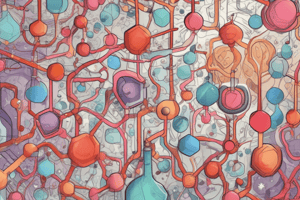Podcast
Questions and Answers
Which property describes a material's ability to deform under stress and return to its original shape?
Which property describes a material's ability to deform under stress and return to its original shape?
- Hardness
- Ductility
- Malleability
- Flexibility (correct)
Density is defined as the volume per unit mass of a substance.
Density is defined as the volume per unit mass of a substance.
False (B)
What physical property measures a material's resistance to scratching and wear?
What physical property measures a material's resistance to scratching and wear?
Hardness
The temperature at which a substance changes from a liquid to a gas is known as its ______ point.
The temperature at which a substance changes from a liquid to a gas is known as its ______ point.
Match the material with its typical characteristic:
Match the material with its typical characteristic:
Which of the following materials is known for its high ductility?
Which of the following materials is known for its high ductility?
Alloys are created to decrease strength and increase corrosion susceptibility compared to pure metals.
Alloys are created to decrease strength and increase corrosion susceptibility compared to pure metals.
What term describes a material's ability to be hammered into thin sheets without breaking?
What term describes a material's ability to be hammered into thin sheets without breaking?
A material with a good ability to support a heavy load without damage possesses high ______.
A material with a good ability to support a heavy load without damage possesses high ______.
Match the alloy to its primary use:
Match the alloy to its primary use:
Which of the following is a characteristic property of ceramics?
Which of the following is a characteristic property of ceramics?
Composites are materials made of a single component to achieve uniform properties.
Composites are materials made of a single component to achieve uniform properties.
What two components make up a composite material?
What two components make up a composite material?
An alloy contains atoms of a ______ element which disrupts the orderly arrangement of atoms.
An alloy contains atoms of a ______ element which disrupts the orderly arrangement of atoms.
Which material is commonly used as a reinforcement in glass-reinforced plastic (GRP)?
Which material is commonly used as a reinforcement in glass-reinforced plastic (GRP)?
Plastic materials are generally good conductors of heat and electricity.
Plastic materials are generally good conductors of heat and electricity.
Name one advantage of using composite materials over single-material components.
Name one advantage of using composite materials over single-material components.
Pure gold is a material with good ______, because it can be easily hammered into different shapes.
Pure gold is a material with good ______, because it can be easily hammered into different shapes.
What is the primary source material for glass?
What is the primary source material for glass?
Match the physical property with its corresponding example:
Match the physical property with its corresponding example:
Flashcards
Melting Point
Melting Point
Temperature at which a substance changes from solid to liquid.
Boiling Point
Boiling Point
The temperature at which a substance changes from liquid to gas.
Density
Density
Mass per unit volume of a substance.
Strength
Strength
Signup and view all the flashcards
Hardness
Hardness
Signup and view all the flashcards
Flexibility
Flexibility
Signup and view all the flashcards
Malleability
Malleability
Signup and view all the flashcards
Ductility
Ductility
Signup and view all the flashcards
Electrical Conductivity
Electrical Conductivity
Signup and view all the flashcards
Material
Material
Signup and view all the flashcards
Metal
Metal
Signup and view all the flashcards
Glass
Glass
Signup and view all the flashcards
Ceramic
Ceramic
Signup and view all the flashcards
Plastic
Plastic
Signup and view all the flashcards
Fiber
Fiber
Signup and view all the flashcards
Alloy
Alloy
Signup and view all the flashcards
Composite
Composite
Signup and view all the flashcards
Composite Materials
Composite Materials
Signup and view all the flashcards
Glass-Reinforced Plastic (GRP)
Glass-Reinforced Plastic (GRP)
Signup and view all the flashcards
Study Notes
- Physical properties classify objects via observable or measurable characteristics.
Physical Properties
- Hardness, mass, and density serve as examples of physical properties.
Melting Point
- Melting point refers to the temperature at which a substance transitions from a solid to a liquid state.
- Copper's high melting point is 1084°C.
- Polyethylene plastic has a low melting point of 110°C.
Boiling Point
- Boiling point denotes the temperature at which a substance transitions from a liquid to a gaseous state.
- Mercury's high boiling point is 365°C.
- Alcohol has a low boiling point of 78°C.
Density
- Density is the mass per unit volume of a substance.
- Metals commonly exhibit high density.
- Wood typically has low density.
Strength
- Strength is a material's capacity to endure a heavy load without sustaining damage.
- Iron is considered to have good strength.
- Glass has poor strength.
Hardness
- Hardness is a material's capacity to resist wear and scratches, and is measured on the Mohs scale from 1-10.
- Diamond is considered to be very hard.
- Talc is considered to be not very hard.
Flexibility
- Flexibility is a material’s capacity to bend without breaking and return to its original shape.
- Rubber demonstrates good flexibility.
- Glass has poor flexibility.
Malleability
- Malleability is a material’s capacity to be hammered or beaten into different shapes without breaking, and is typically used to describe metals.
- Pure gold is very malleable.
- Cast iron is not very malleable.
Ductility
- Ductility refers to a material’s capacity to be stretched into wires.
- Copper has good ductility.
- Ceramic has poor ductility.
Electrical Conductivity
- Electrical conductivity measures how readily electric current passes through a substance.
- Iron has good electrical conductivity.
- Plastic has poor electrical conductivity.
Classes of Materials
- Materials are substances used to create objects.
- Materials are classified into 5 main classes.
Metal
- Metals are extracted from the ground.
- Metals are shiny, good conductors of heat and electricity, malleable, and ductile.
- Some metals corrode easily, while others do not.
Glass
- Glass is made from sand.
- Glass is transparent and brittle.
- Glass is a poor conductor of heat and electricity that does not corrode, but can be moulded into shapes.
Ceramic
- Ceramics are non-metallic solids made from clay.
- Ceramics are hard but brittle with a high melting point.
- Ceramics are poor conductors of heat and electricity that do not corrode.
Plastic
- Plastics are made from petroleum.
- Plastics are strong but light, with low density.
- Plastics do not corrode easily, are poor conductors of heat and electricity and can be moulded into shapes.
Fibre
- Fibres can be manmade or natural.
- Fibres can be spun into threads and woven into fabrics, and can absorb dyes.
Alloys
- An alloy is a mixture of two or more elements, with at least one being a metal.
- Alloys are created to increase strength or resistance to corrosion.
- Alloys consist of atoms in a foreign element that disrupt the orderly arrangement of atoms, making it difficult for layers of atoms to slide over each other when force is applied.
Amalgam
- Amalgam is an alloy made of 50% mercury, 25% silver, 14% tin, 8% copper, and trace amounts of indium and palladium.
- Amalgam is used for dental fillings.
Brass
- Brass is an alloy composed of 65% copper and 35% zinc.
- Brass is used for jewelry and machine bearings.
Bronze
- Bronze is an alloy made up of 90% copper and 10% tin.
- Bronze is used for machine parts.
Duralumin
- Duralumin is an alloy containing 95% aluminum, 4% copper, and 1% magnesium, manganese, and iron.
- Duralumin is used in aircraft construction and bicycle parts.
Hard Steel
- Hard steel is an alloy containing 99% iron and 1% carbon.
- Hard steel is used for cutting tools.
Composites
- A composite combines two different materials to create a new substance with enhanced or specialized properties.
- Composites consist of a matrix and a reinforcement.
Glass-Reinforced Plastic (GRP)
- Glass-reinforced plastic (GRP) is a composite of glass and plastic.
- Glass is corrosion resistant.
- Plastic is strong, and light and can be moulded into shapes.
- GRP does not break when bent or moulded, can withstand force from collisions, and is lightweight.
Studying That Suits You
Use AI to generate personalized quizzes and flashcards to suit your learning preferences.




